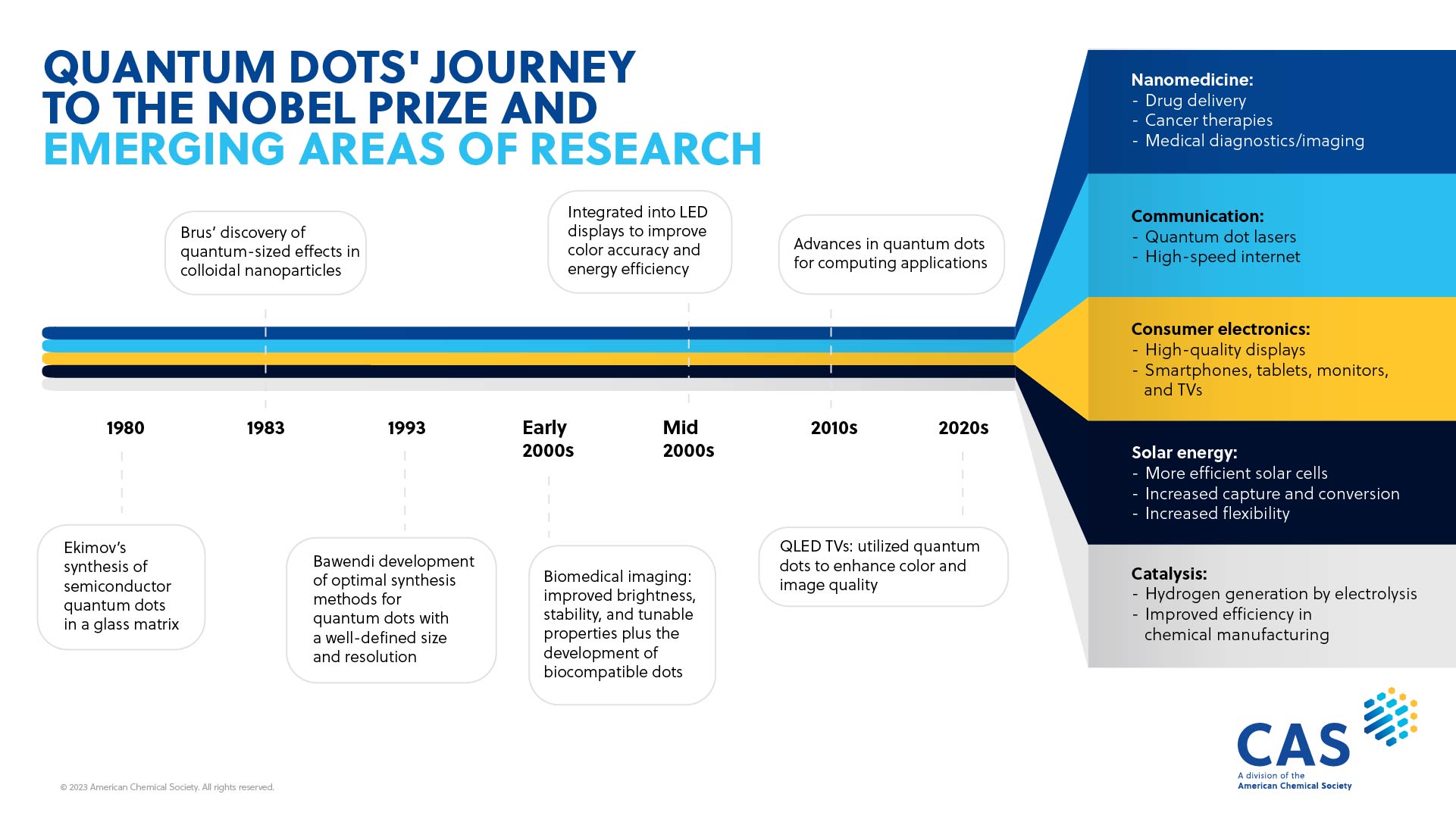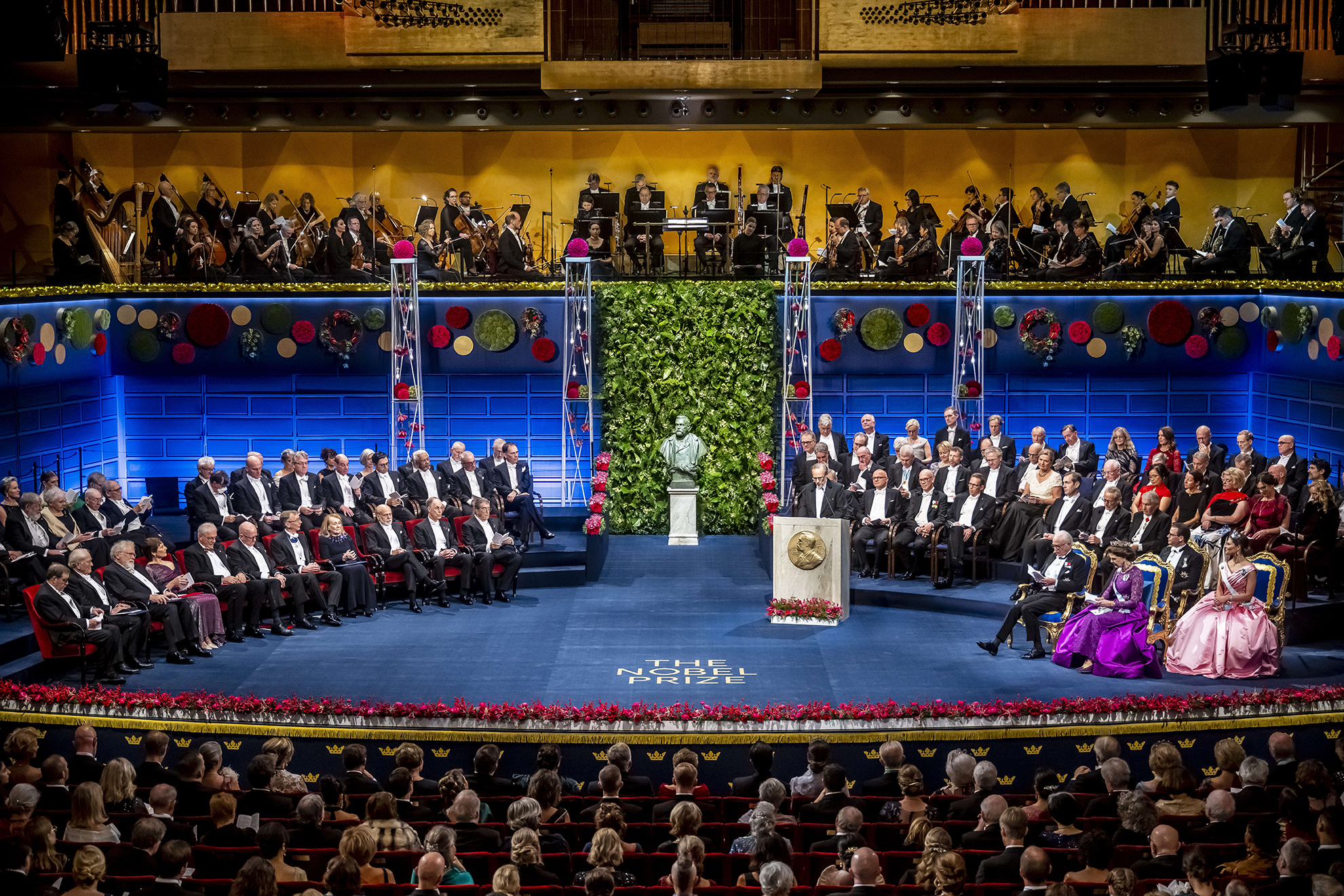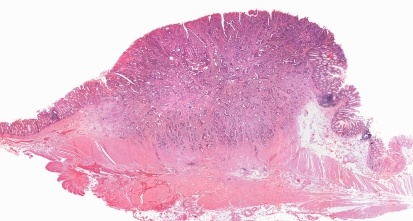Gain new perspectives for faster progress directly to your inbox.
Since the early 1980s when scientists Alexei Ekimov, Louis Brus, and Alexander Efros discovered quantum dots (QDs), this technology has quickly developed into wide-ranging, impactful applications. The journey to the Nobel Prize has been filled with critical milestones (Figure 1), but their perseverance to continue advancing has finally been recognized by the Nobel Committee.
These semiconducting quantum dot nanocrystals (such as zinc selenide/sulfide, indium gallium arsenide, cesium lead iodide perovskite, or graphene) have revolutionized displays, such as high-brightness LED screens, improving color accuracy and energy efficiency. This was exemplified by the introduction of commercial quantum dot TVs in 2013.
Their size-dependent fluorescence has also played a pivotal role in advancing renewable energy, particularly in solar cells. The sustainable room temperature preparation of QDs in colloidal solutions has enabled more diverse applications with exceptional adaptability, such as in photocatalysis for hydrogen generation or organic pollutant reduction. They have also helped biomedical imaging, where they have become a vital tool for precise drug delivery and diagnostics for diseases such as cancer.
Quantum dots' influence continues to expand, with developments such as quantum dot LEDs, ferromagnetic particle inspection, photoconductors, and photodetectors, with tremendous potential for use in quantum dot lasers and quantum computers, demonstrating their ever-evolving impact on science and technology.
The road to the Nobel Prize has been a long journey but the opportunities and impacts are far-reaching. Today, there is emerging research in the areas of nanomedicine that is reshaping drug delivery, diagnostics and biomedical imaging, consumer electronics, sustainable energy, and even more sustainable catalysis opportunities in the future.

What are the most overlooked discoveries that have yet to win a Nobel?

As the science community gears up for Nobel season, we are always excited to prognosticate, conjecture, and brainstorm on the winners. Yet, this year, we are taking a different approach to Nobel season by featuring our scientists as they talk about which discoveries they’re most surprised have yet to win this prestigious award. We invite you to join us in the conversation on LinkedIn as we review some of the most remarkable and influential scientific breakthroughs that have yet to win a Nobel Prize. These discoveries span from the nanomolecular level to massive OLED screens and have implications across chemistry, biology, and medicine. Join the conversation and vote in our upcoming poll on LinkedIn as we reveal our takes on the most overlooked discoveries that have yet to win this award.
How OLEDs could light up the Nobel Prize
Today, OLEDs are appearing everywhere on phones, media players, portable gaming systems, lighting, and even car radios. The technology is credited to chemists Ching Wan Tang and Steven Van Slyke for pioneering the first practical OLED device in 1987 while working at Eastman Kodak. This has paved the way for a new generation of display technologies across industries.
An Organic Light-Emitting Diode is a light-emitting diode (LED) in which the emissive electroluminescent layer is a film of organic compound that emits light in response to an electric current. This organic layer is situated between two electrodes; typically, at least one of these electrodes is transparent. Due to their lightweight nature, they can be fabricated on flexible plastic substrates, have better picture quality, and can be printed onto any suitable substrate by an inkjet printer.
CAS has indexed over 113,000 documents related to OLEDs across multiple areas of application since Tang and Van Slyke’s first practical device in 1987. With 30,000 journals and 80,000 patents, this illustrates their central importance in technological development.
Join the conversation and comment on the most overlooked topics for the Nobel Prize with us on LinkedIn.
The case for the Nobel Prize with metal-organic frameworks
Building complex, tunable, porous material structures by self-assembly of simple molecular building blocks has remained elusive for a long time. However, since the 1990s when they were first discovered by Omar M. Yaghi and Makoto Fujita, metal-organic frameworks (MOFs) have proven to be a promising solution. By linking metal atoms or clusters (such as Zn or Cu) to organic compounds (such as carboxylates or imidazolates), MOFs combine precisely controlled rigid nanostructures and chemical functionalization unavailable to traditional porous materials.
By varying the nature of the metal and organic molecule building blocks as well as the preparation method (such as solvothermal or hydrothermal synthesis) and organic solvent, the MOFs can be finely tuned. Tweaking the surface area and adsorption-based properties in addition to the electronic, magnetic, and luminescent properties also leads to a diverse range of applications. What started as promising materials for gas capture, separation, storage (such as hydrogen, carbon dioxide, and oxygen), and heterogeneous catalysis, has now shown applications as biosensors/bioimaging materials, drug delivery systems, binding and removal of guest molecules, desalination/water treatment, or even semiconductors and ferroelectrics.
Join the conversation and comment on the most overlooked topics for the Nobel with us on LinkedIn.
Synthesizing DNA unlocked the secrets of life
It is surprising that the chemical synthesis of DNA has not won a Nobel prize because it transformed DNA synthesis from a specialized exploration into a widely used research, diagnostic, and forensic tool. This breakthrough dramatically advanced biological research and helped launch the biotechnology industry. Marvin H. Caruthers developed methods for the phosphoramidite synthesis of DNA, which efficiently and accurately assembled nucleotides into short strands of DNA, enabling genetic engineering of new biopharmaceuticals, forensic DNA fingerprinting, and the human genome project. It is used today by scientists for many different aspects of biomedical research including genetic sequencing, drug and vaccine developments, disease diagnostics, and pathogen tests such as COVID-19 tests. This technology was also critical for the development of other biomedical techniques like the polymerase chain reaction, which is used to amplify DNA to study in greater detail.
Since Caruthers pioneered these tools, CAS has indexed more than 80,000 documents on DNA synthesis. CAS has indexed 243 documents authored by Dr. Caruthers, including over 30 patents. The foundational publication that shared this idea with the world, “Deoxynucleoside phosphoramidites—A new class of key intermediates for deoxypolynucleotide synthesis” has been cited over 3400 times.
Have another discovery that we missed? Let us know! Join the conversation and comment on the most overlooked topics for the Nobel with us on LinkedIn.
Gut microbiome advances are reshaping future outcomes
Gut microbiome research has expanded exponentially in recent years, with fecal microbiota transplantation (FMT) at the forefront of this research. It has provided valuable insights into the complex interplay between the microbiome and human health, prompting scientists to explore how gut bacteria impact various bodily functions, from digestion and metabolism to the immune system and mental health. One of the most notable contributions of FMT is its remarkable success in treating gastrointestinal conditions such as recurrent Clostridioides difficile infection, which is often a life-threatening bacterial infection that can be resistant to conventional antibiotics. Introducing a diverse and healthy population of gut bacteria through FMT can help restore the microbial balance in the recipient’s intestines, alleviate symptoms, promote recovery, and combat antibiotic resistance, a growing global health concern.
While FMT is primarily associated with gut-related conditions, its potential applications extend beyond the digestive system. Researchers are investigating its use in treating conditions such as Inflammatory Bowel Syndrome (IBS), Crohn’s disease, ulcerative colitis, obesity, allergies, autoimmune diseases, and even neurological conditions like Parkinson’s disease and depression.
The history of FMT has been traced back to the 4th century and has been highly regarded since 2013, when the United States Food and Drug Administration approved it for treating recurrent and refractory C. difficile infection. CAS has over 400 patents dedicated to FMT invention and its methodology and more than 5,000 journal publications in the last 5 years. These groundbreaking discoveries are reshaping our understanding of the microbiome’s influence on overall health. Fecal microbiota transplantation represents a prime example of how medical innovation can emerge from unconventional sources, challenging traditional approaches to treatment.
What do you think? Join the conversation and comment on the most overlooked topics for the Nobel with us on LinkedIn.
Are dendrimers, nanoscience, and supramolecular chemistry ready for a Nobel Prize?
Traditionally, many key benefits of a drug or pharmaceutical cannot be realized because of their poor solubility, high toxicity, or stability problems. However, the use of dendrimers as drug delivery vehicles can solve many of these problems.
Dendrimers are branched polymers starting from a core followed by repeating branching points. Their adjustable size, interactions with cell membranes, and stable characteristics of their internal structure are ideal for delivering active pharmaceuticals. The synthesis of dendrimers is challenging and not cost-efficient, but their various application potentials still drive this field of research forward.
Dr. Didier Astruc established systematic synthesis of dendrimers, followed by the functionalization from transition metal nanoparticles like gold nanoparticles. This research solved the obstacles from the dendrimer synthesis and created sustainability of dendrimer-based catalytic chemistry based on the low catalyst loading amount and high catalytic efficiency. Upon this research, sustainable catalysis using metal nanoparticles-embedded dendrimers can be achieved, relieve our energy consumption, and increase the sustainability for the next generation.
Connect with us and comment on the most overlooked topics for the Nobel on LinkedIn.
Nobel worthy: mRNA vaccines beyond COVID
While much of the world has already seen the impact that mRNA has had on vaccines for COVID-19, it may be time to recognize Dr. Katalin Karikó and Dr. Drew Weissman for their outstanding contributions to nucleoside modifications to suppress RNA immunogenicity on top of their pioneering work on messenger RNA.
Typically, mRNA molecules in their natural state are quickly destroyed when injected into the body, are extremely inflammatory, and cannot instruct cells to make enough viral protein to trigger an immune response. After years of experimentation, Karikó and Weissman created a modified version of mRNA. In this modified version, uridine was substituted with N1-methylpseudouridine (m1Ψ). With this discovery, mRNA transformed into a highly effective vaccine platform. The substitution allows the modified mRNA to avoid immune detection, remain active longer, and enter target cells to create antigens to fight disease.
The mRNA platform is a much quicker platform than the traditional vaccine platforms, which can require protein purification or virus inactivation. The speed of the platform could be vital for treating other diseases and future outbreaks like cancer treatment, immunotherapy, and genetic disease treatment.
CAS has indexed over 500 documents and 50 patents authored by Dr. Karikó and Dr. Weissman, including 7 joint patents. Pfizer/BioNTech and Moderna have licensed their joint patents on nucleoside-modified RNA for COVID-19 vaccines.
Their most cited works include:
- Suppression of RNA recognition by toll-like receptors: The impact of nucleoside modification and the evolutionary origin of RNA, Immunity (2005), 23(2), 165-175. Cited more than 1900 times.
- Incorporation of pseudouridine into mRNA yields superior nonimmunogenic vector with increased translational capacity and biological stability. Molecular Therapy (2008), 16(11), 1833-1840. Cited over 1400 times.
- mRNA Is an Endogenous Ligand for Toll-like Receptor 3, Journal of Biological Chemistry (2004), 279(13), 12542-12550. Cited over 1200 times.
What do the people say? Vote on the most overlooked topics for the Nobel with us on LinkedIn.



